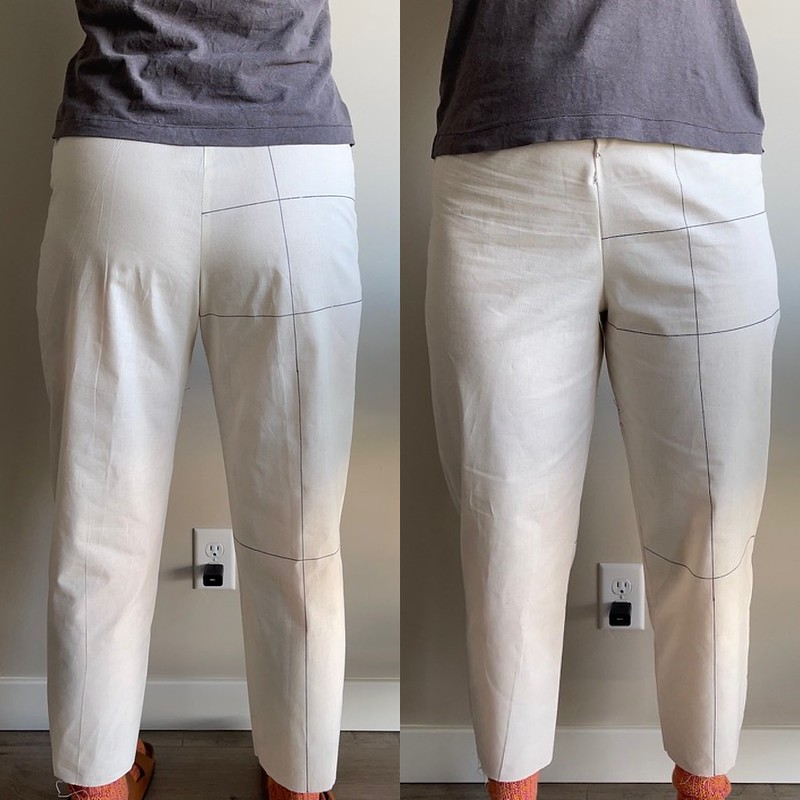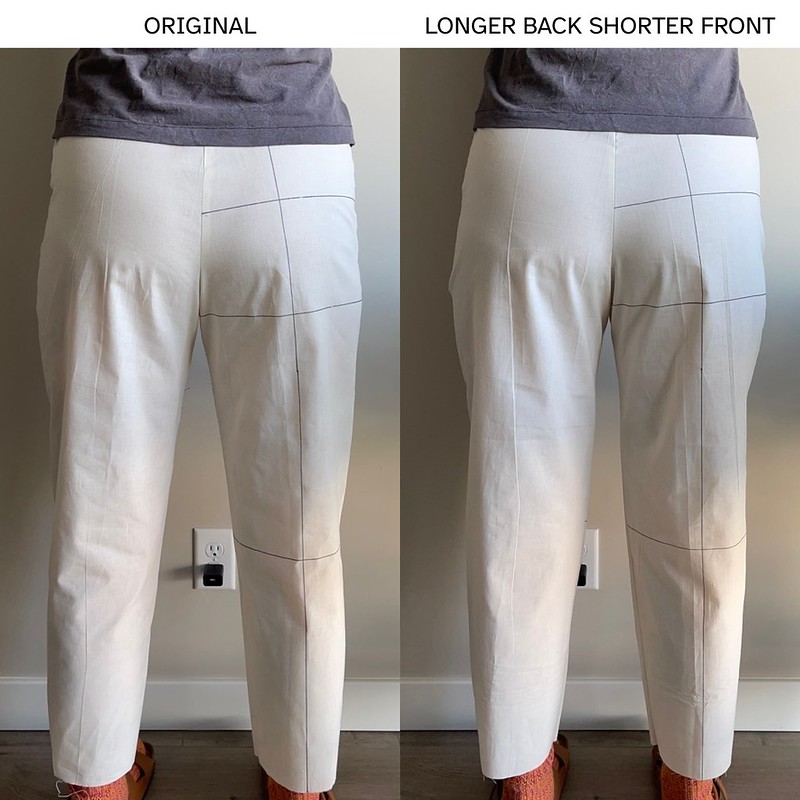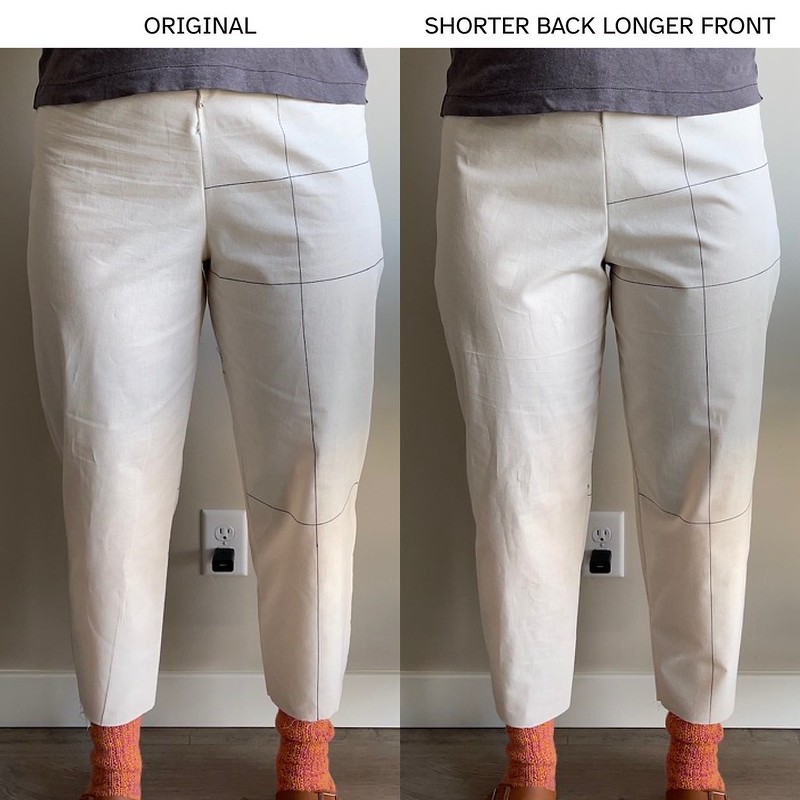
I’ve covered a lot about balancing pants from left to right, but I haven’t talked about balancing pants from front to back. The purpose of this post is to talk about something I’ve not seen discussed, and that is about getting the crotch point location correct. I will show you how to find your crotch point and what happens if your crotch point is too far forward or backward, even if you have the correct crotch length.
Melly Sews has a great tutorial about crotch lengths that are too short or long or if the curve is too steep or curvy. These issues are pretty apparent since you know when you have a wedgie in the front or back of your pants. I want to discuss what happens when the crotch curve fits in size and length but isn’t balanced, so it doesn’t drape correctly!
Definitions

Issue 122
(Decr 2005/Jan 2006, pg. 36)
Let’s start out with some definitions.
- Crotch length is the length from the top of center front in between your legs to the top of center back.
- Crotch point is at the bottom of the pelvic floor and is where the front crotch curve and back crotch curve meet.
- Crotch level is the horizontal line that goes through the crotch point.
- Crotch depth is the perpendicular measurement from the crotch level to your front and back waistband. The crotch depth can be different for the front and back if your waistband sits differently front to back.
- Crotch width is the empty space between the front and back pieces where your body will reside in the pants when worn.
I’ve never found measuring the crotch length or depth particularly helpful in determining where the front curve meets the back curve. Both measurements depend on waistband placement, which changes from pattern to pattern. Crotch width is hard to translate because it is defined by empty space and changes depending on the horizontal level you measure. Crotch width is often measured 2 inches above your crotch point, which feels like an arbitrary point. I don’t like random points.

I prefer using crotch hook length. To obtain this measurement is to draw a horizontal line at the crotch level. My image above contains a 3/8 inch seam allowance, which is why the crotch level is slightly lower. Next, draw a line vertical from the center front or center back down to the crotch level. The crotch hook length is the distance from where these two lines meet to the inseam. I have a crotch hook length of 5 inches for the back. I have a crotch hook length of 4.5 inches for the front.
Yes, I understand the crotch hook length uses the location of your waistband, so I haven’t addressed that issue. But for me, this is an easier way to obtain the crotch width. I’m measuring the pattern and not measuring the void between patterns. I don’t have a magic ruler that can measure through my body, exactly 2 inches above my crotch point.
How to Find Your Crotch Point

Anatomically the crotch point should hit at the center of your perineum, the yellow dot on the diagram. Towards the back body, you have the anus, and towards the front body, you have the scrotum (male) or vulva (female). The center of your perineum is halfway in between.

If anatomy just isn’t your thing, you can also use a plumb bob to find your crotch point. I cut two long pieces of string. One piece of string was held like I was trying to measure my crotch length, and the second piece of string was securely fastened at the center with a heavy-ish object hanging from it to act as a plumb bob.
How to Measure Your Crotch Hook Length

I haven’t been particularly successful in accurately measuring my crotch hook length because the body squishes, which can distort values. I’ve tried taking my L-shaped ruler and placing the vertical portion gently against my body while keeping the horizontal portion level. If you know your crotch point, you can find that point on the ruler to obtain your crotch hook length (yellow arrow on body, red arrow on pattern). This measurement isn’t entirely precise, but it will give you a general idea of length.

Again, I don’t find this measurement perfect, but it is helpful to get a general idea. I place my L-shaped ruler gently again my body while keeping the horizontal portion perfectly level. The crotch hook length is the distance to your crotch point (yellow arrow on body, red arrow on pattern). Many patterns have front crotch hook lengths of ~1.5 inches, but clearly, I knew I needed to add more length from this method!
Perfect Fit

Let’s say you have a pant pattern, and the crotch area fits perfectly. The crotch length is long enough, the crotch hook length is just right, so you don’t have any unfortunate wedgies, and your crotch depth is just right that the waistband sits just right.
What would happen if the crotch point was shifted forward or backward?
Longer Back Shorter Front

I added 1 inch to the back crotch hook length in this example and removed 1 inch from the front crotch hook length. The overall crotch length is the same, so how does this affect the drape and fit of the pants?

What happens when I move the top of the plumb bob one inch forward from my crotch point? On the left, you can see that I found my crotch point; the bottom of the plumb bob is at the center of my ankle. If I move the plumb bob 1 inch forward from my crotch point, now the key is in front of my ankles.
How does this translate to drape? If the center of gravity of your pants is hitting in front of the center of gravity of your body, the pants will swing in the direction of your body’s center of gravity. In other words, your pants will want to hang towards your back body.

Let’s look at the crotch shape diagram. Notice that the center front is lower than the original in grey. The center side seam is also lower. The back waistband is higher. Shifting the crotch point forward will result in pants that swing more towards the back body. If the center of gravity doesn’t match your body’s center of gravity, you’ll see wrinkles and draglines that suggest the fit is off.

Here is a quick little disclaimer: draglines and wrinkles only tell you that fit is off. Trying to decipher them when they can be obtained in many ways isn’t helpful. Don’t be frustrated if all my photos of poor fit start looking the same. It’s about measuring your body and pattern to make adjustments, not about obtaining some wizard-level mastery of dragline/wrinkle divination. There’s no way I can look at these wrinkles and know what needs to be altered on the pattern. Instead, I know what needs to be altered, so I can extrapolate what the wrinkles might be suggesting.
I think you can subtly tell the front waistline wants to be pulled down compared to the original. There are obviously draglines around the center front, and you can kind of see the front-to-back swing because there are more prominent folds along the side seams.

For the back, the wrinkles under the butt have increased, and it is very, very subtle, but if you look at the right knee, you can see the distortion associated with pants being pulled up too much. As I walk around in these pants, they sag in the front and feel tight. The back feels like it wants to be a wedgie.
Shorter Back Longer Front

In this example, I removed 1 inch from the back crotch hook length and added 1 inch to the front crotch hook length. The overall crotch length is the same.

What happens when I move the top of the plumb bob one inch backward from my crotch point? On the left, you can see that I found my crotch point; the bottom of the plumb bob is at the center of my ankle. If I move the plumb bob 1 inch backward from my crotch point, the bottom is now behind my ankles.
How does this translate to drape? If the center of gravity of your pants is hitting behind the center of gravity of your body, the pants will swing in the direction of your body’s center of gravity. In other words, your pants will want to hang towards your front body.

Let’s look at the crotch shape diagram. Notice that the front waistband is slightly higher than the original in grey. The back waistband is lower. Shifting the crotch point backward will result in pants that swing more towards the front body.

Remember that the pants want to find balance, which means the pant will swing forward, resulting in wrinkles around the center front. This version no longer feels tight around the upper thigh, but obviously, the fit is off.

With the back crotch hook length shorter, it now feels tighter around my butt. Again, it’s subtle, but the right knee’s wrinkles suggest that the leg is collapsing on itself as it tries to swing forward. As I walk around in these pants, they sag in the back and feel tight. Luckily, I’ve avoided the wedgie feeling in the front, but they definitely don’t look great.
Summary

I didn’t take any photos from the side because it wasn’t terribly helpful. The pant swing would have been more evident in wider pant legs. Hopefully, you can tell that even though the overall crotch level is correct, if the crotch point is too far forward (left image), the front is too tight and collapses. If the crotch point is too far backward (right image), the front is loose but looks like it is being pulled up.

Again, if the crotch point is too far forward (left image), there’s excess fabric, and it all wants to ride up. The wrinkles right along the center front suggest there’s too much fabric. When the crotch point is too far backward (right image), you remove the wrinkles at the center back because the pants are a bit too tight, and the pants want to swing towards the front body. And yes, I understand the wrinkles under the butt look the same for both versions; the difference is whether you have wrinkles along the center back (left image) or not (right image).
Compare and contrast the right knee. When the pants swing towards the back body on the left, the leg shows draglines from the knee up to the butt and from the knee down to the ankle. When the pants swing towards the front body on the right, the leg shows fabric that wants to puddle at the knee.
Conclusions
I would suggest getting the right to left balance on your pants correct before addressing the crotch point balance. If you notice, with all my pants, the legs are hanging straight from left to right. In other words, the legs aren’t swinging off-center and causing their own set of draglines and wrinkles. My suggested order of fit is:
- Balance the knee, if needed.
- Balance the pant leg at the hip, as needed.
- Adjust overall crotch level length, because that will impact crotch hook length.
- Finally, find your crotch point and adjust your crotch hook length as needed.












Thank you for another great post with visual comparison and analysis. Having a research science background, I admire your careful consideration of each variable.
What the images show to me is that the bottom crotch point can be erroneously shifted well away from the correct bottom of the body (±1″!) and the overall fit won’t change substantially. The wrinkle patterns all look within the range one would expect from different stances, different pressing, or slight stretching of the material. Indeed, you noted the side photos didn’t differ remarkably or indicate clear misfitting.
The message should arguably be one of reassurance rather than emphasis of a new and worrisome fitting detail: Of course the inseam ideally should vertically intersect the bottom of the body, but a quick visual check by a partner—or the plumb weight method—is sufficient. A fraction-of-an-inch error doesn’t change things substantially as it might in a waist or crotch length. (At least that’s the conclusion I draw from this pictures.) Sometimes it’s nice to identify things that don’t matter as much!
This doesn’t mean your work or analysis isn’t very valuable. Identifying a lack of strong correlation is still a great contribution. Again, this can be very reassuring for the novice when wondering which details matter most.
LikeLiked by 1 person
I’ve made several different patterns since this post, and I agree with you about crotch point placement. The location can change depending on the intended style of the pant and is generally less important for fit. I haven’t had to contend with crotch location or length since I started using overall torso circumference when selecting pant size. I appreciate your feedback and comments. Thank you!
LikeLike
Is there a reason you wouldn’t use your low hip point at rise to measure your crotch hook length instead of your waist line at rise?
LikeLiked by 1 person
If you know that your center grainline is well placed at the hip level and you don’t need to make adjustments, there’s no reason you can’t use the hip line instead of the waistline. Traditionally it is done with the waistline because that’s the level at which the pants will hang. Using the waistline will be more standard.
LikeLike
Ve-ry interesting! I have wondered about this too, ie moving the center of gravity closer front or farther back. I agree it’s not the same as full-butt adjustment, etc. Thanks for presenting your systematic experiments.
LikeLiked by 1 person